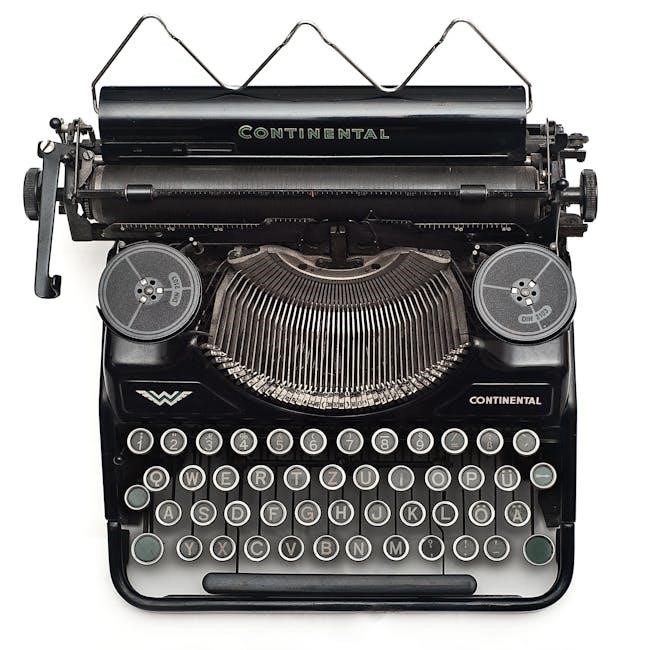Welcome to the Uponor Thermostat Manual, your comprehensive guide for installers and users․ This manual covers installation, operation, and troubleshooting for hydronic heating systems, ensuring optimal performance and comfort․ Designed to be user-friendly, it helps maximize energy efficiency and system longevity․
1․1 Overview of Uponor Thermostat
The Uponor Thermostat is designed for precise temperature control in hydronic heating systems, offering models like the T-27 with a large LCD display and capacitive keys․ It features advanced functions such as auto-balance, bypass, and remote access via home automation systems․ The thermostat supports programmable scheduling and energy-saving modes, ensuring comfort and efficiency․ Compatible with various systems, it integrates seamlessly with Uponor’s underfloor heating solutions, providing user-friendly operation and customizable settings for optimal performance․
1․2 Importance of the Manual
This manual is essential for understanding and optimizing the Uponor Thermostat’s functionality․ It provides detailed instructions for installation, operation, and troubleshooting, ensuring safe and efficient use․ The manual caters to both installers and end-users, offering clear guidelines for programmable scheduling, energy-saving modes, and advanced features like bypass and auto-balance․ Adhering to the manual prevents potential system damage and safety hazards․ It also helps users maximize energy efficiency and system longevity, making it an indispensable resource for anyone working with the Uponor Thermostat․

Installation of Uponor Thermostat
Installing the Uponor Thermostat requires careful preparation and adherence to the manual․ Ensure compatibility with your heating system and follow step-by-step instructions for wiring and mounting․ After installation, perform checks to verify functionality and address any issues promptly for optimal performance and safety․
2․1 Pre-Installation Requirements
Before installing the Uponor Thermostat, ensure you have read the manual thoroughly․ Verify the thermostat is compatible with your heating system and voltage requirements․ Check existing wiring and components for damage or wear․ Gather necessary tools and materials, such as a voltage tester and compatible wiring․ Ensure the power is turned off and the system is cool․ Prepare the mounting location according to the manual’s specifications․ If applicable, configure network settings for remote access․ Proper preparation ensures a safe and successful installation process․
2․2 Step-by-Step Installation Process
Mount the thermostat on a flat surface, ensuring good visibility and accessibility․ Connect the wires to the appropriate terminals, following the wiring diagram in the manual․ Secure the wires tightly to avoid loose connections․ Power on the thermostat and perform a system test to ensure proper function․ Configure basic settings like temperature range and operation mode․ Finally, review the installation to ensure all connections are correct and the system operates smoothly․ Always follow safety guidelines and manufacturer instructions for a successful setup․
2․3 Post-Installation Checks
After installation, perform a visual inspection to ensure all wires are securely connected and the thermostat is properly mounted․ Test the thermostat by turning the heating system on and off to confirm responsiveness․ Verify that the display shows accurate temperature readings and that all buttons or controls function correctly․ Check for any error messages or unusual behavior․ Ensure the system cycles correctly and maintains the set temperature․ Review the manual to confirm all settings align with your system requirements․ Finally, ensure no leaks or damage to the system during installation․

Operating the Uponor Thermostat
Learn how to operate your Uponor Thermostat effortlessly․ This section guides you through basic operations, manual mode, and auto mode with scheduling for optimal comfort and efficiency․
3․1 Basic Operations
The Uponor Thermostat operates with a user-friendly interface, allowing easy temperature control․ Basic operations include turning the system on/off, adjusting the setpoint temperature, and switching between modes․ The touchscreen display provides clear feedback, showing the current room temperature and desired settings․ Use the capacitive keys to navigate and adjust settings․ The thermostat also features a large LCD display for readability․ Regular operations ensure smooth functionality, while advanced features like scheduling can be accessed through the menu․ Always refer to the manual for detailed guidance on basic and advanced operations․
3․2 Manual Mode
The Manual Mode allows you to set a constant temperature without scheduling․ Simply navigate to the mode selection menu and choose Manual Mode․ Use the touchscreen or capacitive keys to adjust the desired temperature․ This mode is ideal for situations where consistent heating is needed without time-based adjustments․ The thermostat will maintain the set temperature until manually changed․ Manual Mode is straightforward and offers precise control for immediate comfort needs․ Ensure the thermostat is in this mode for constant operation, bypassing any automated schedules or adjustments․
3․3 Auto Mode with Scheduling
Auto Mode with Scheduling enables the thermostat to automatically adjust heating based on a pre-set timetable․ This mode optimizes energy usage by aligning temperature changes with your daily routine․ To activate, select Auto Mode and create or edit schedules via the touchscreen interface․ You can program different temperatures for various times of the day, ensuring comfort and efficiency․ The thermostat will automatically switch between heating and standby based on your schedule․ Adjustments can be made at any time without affecting the overall program, allowing flexibility while maintaining energy-saving benefits․
3․4 Setting the Clock
To set the clock on your Uponor Thermostat, navigate to the Main Menu, then select Settings, and choose Clock Settings․ Use the touchscreen to set the current time, date, and time zone if applicable․ Ensure the time format (12 or 24-hour) matches your preference․ After setting, confirm the changes to save․ The thermostat will now display the correct time, ensuring schedules and automated functions operate accurately․ For precise instructions, refer to your specific model’s manual, as interfaces may vary slightly․ Accurate clock settings are crucial for scheduling and energy management․
3․5 Adjusting Comfort Levels
Adjusting comfort levels on your Uponor Thermostat allows you to customize temperature settings for optimal comfort․ To do this, access the Main Menu, select Comfort Levels, and choose your desired temperature for heating or cooling․ Use the touchscreen to increase or decrease the setpoint․ You can also set different levels for morning, day, evening, and night to match your lifestyle․ Ensure the temperature is set within the recommended range for energy efficiency․ Regularly reviewing and adjusting these settings helps maintain comfort while optimizing energy use․ This feature is essential for personalizing your heating experience․ Always refer to your manual for model-specific guidance․

Programming and Scheduling
Programming and scheduling on the Uponor Thermostat allow you to create customized temperature plans․ Use the menu to set daily schedules, ensuring efficient energy use and comfort․ The thermostat supports multiple modes, enabling you to optimize heating based on your routine․ This feature is designed to enhance convenience while maintaining optimal performance․ Refer to the manual for detailed step-by-step guidance on programming and scheduling options․
4․1 Creating a Schedule
Creating a schedule on the Uponor Thermostat is straightforward․ Access the menu, select “Scheduling,” and choose “Create New Schedule․” Set your desired temperature and time for each day․ Use the touchscreen to adjust settings, ensuring they align with your daily routine․ The thermostat allows multiple time slots, enabling precise control․ Save your schedule to activate it immediately․ For detailed instructions, refer to the manual, which provides step-by-step guidance to help you customize your heating preferences efficiently․
4․2 Editing the Schedule
Editing a schedule on the Uponor Thermostat is simple․ Navigate to the “Scheduling” menu, select “Edit Schedule,” and choose the specific time slot you wish to modify․ Adjust the temperature or time as needed using the touchscreen interface․ You can also delete or add new time slots to suit your preferences․ After making changes, save the updated schedule to ensure it takes effect․ The thermostat’s intuitive design allows for seamless adjustments, ensuring your comfort and energy efficiency remain optimized․
4․3 Understanding Scheduling Modes
The Uponor Thermostat offers two primary scheduling modes: Manual and Auto․ In Manual Mode, you set a constant temperature․ Auto Mode allows programming different temperatures for specific times or days․ Additionally, there’s an Eco Mode for energy-saving settings․ These modes enhance flexibility, enabling you to customize your heating schedule according to your lifestyle․ Use the touchscreen to select and configure the mode that best suits your needs, ensuring comfort and efficiency throughout the day․

Advanced Features of Uponor Thermostat
The Uponor Thermostat includes advanced features like Bypass Function, Auto-Balance, and Remote Access․ These enhance performance, simplify system management, and provide seamless integration with smart home systems․
5․1 Bypass Function
The Bypass Function in the Uponor Thermostat optimizes system performance by automatically regulating water flow․ It ensures consistent temperatures and reduces energy consumption․ To activate, navigate to the Main Menu, select Settings, then choose the Bypass option․ This feature is particularly useful in zoned systems, allowing precise control over individual areas․ The function ensures that the system operates efficiently, maintaining comfort while minimizing energy use․ Proper configuration is essential for optimal results, as outlined in the manual․
5․2 Auto-Balance Function
The Auto-Balance Function simplifies system setup by eliminating manual balancing of the manifold during installation․ It ensures even distribution of water across all heating zones, enhancing efficiency and comfort․ This feature requires the Interface I-76 and is activated during the initial setup process․ By automating balancing, it reduces installation time and potential errors․ The Auto-Balance Function is a key advancement in Uponor’s thermostat technology, providing seamless integration with hydronic systems for optimal performance and energy savings․
5․3 Remote Access and Control
The Uponor Thermostat offers Remote Access and Control, enabling users to manage their heating system via smartphone or tablet․ This feature provides convenience and energy efficiency by allowing adjustments to temperature settings, scheduling, and system modes from anywhere with an internet connection․ The intuitive interface ensures easy navigation, while real-time monitoring helps optimize comfort and energy use․ Remote access is secure and reliable, offering peace of mind and enhanced control over your heating system․ This feature is particularly useful for maintaining consistent temperatures and addressing any issues promptly․
5․4 System Integration
The Uponor Thermostat seamlessly integrates with various home automation systems, enhancing functionality and control․ Through compatibility with systems like RS485 and other communication protocols, it ensures centralized management of heating and cooling․ This integration allows for synchronized operation with other smart devices, optimizing energy use and comfort․ Users can access advanced features and customize settings to suit their preferences, making it a versatile solution for modern smart homes․ This capability ensures efficient system performance and adaptability to different automation setups․

Troubleshooting Common Issues
Identify and resolve common thermostat issues using diagnostic tools and error codes․ Refer to the manual for step-by-step solutions to ensure optimal performance and system reliability․
6․1 Common Problems and Solutions
Common issues with the Uponor thermostat include display errors, connectivity problems, or temperature mismatches․ Check for loose wiring or incorrect settings․ Ensure the thermostat is properly paired with the system․ Reset the device if necessary․ For display issues, clean the screen gently․ If the thermostat isn’t responding, verify power supply․ Refer to the manual for specific error codes and solutions․ Adjust settings or restart the system to resolve most problems․ If issues persist, contact Uponor support for assistance․ Always follow safety guidelines during troubleshooting․
6․2 Error Codes and Their Meanings
The Uponor thermostat displays error codes to indicate specific issues․ Common codes include E1 for temperature sensor malfunctions, E2 for communication errors, and E3 for system overheat protection․ Refer to the manual for detailed explanations of each code․ Understanding these codes helps diagnose problems quickly․ For example, E1 may require checking sensor connections, while E2 could indicate a wiring issue․ Always follow the manual’s guidance for resolving errors to ensure system functionality and safety․ If unsure, contact Uponor support for further assistance․
6․3 When to Contact Customer Support
Contact Uponor customer support if issues persist after troubleshooting․ Reach out for complex problems like system malfunctions or unresolved error codes․ If the thermostat fails to respond or display correctly, professional assistance is recommended․ Additionally, contact support for firmware updates or compatibility questions․ Ensure to have your model number and error details ready for faster resolution․ Visit the official Uponor website or call the support hotline for guidance․ Don’t hesitate to seek help for unresolved issues to maintain optimal system performance and safety․

Maintenance and Care
Regularly clean the thermostat’s display and sensors to ensure accuracy․ Check batteries and connections for wear․ Schedule annual professional inspections to maintain optimal performance and longevity․
7․1 Regular Maintenance Tips
Regular maintenance ensures your Uponor thermostat operates efficiently․ Clean the display and sensors with a soft cloth to maintain accuracy․ Inspect batteries for corrosion and replace them as needed․ Check wiring connections to prevent malfunctions․ Update firmware periodically for enhanced performance․ Schedule annual professional inspections to verify system functionality․ Always refer to the manual for model-specific maintenance recommendations to ensure longevity and optimal performance․
7․2 Cleaning the Thermostat
Cleaning your Uponor thermostat is essential for maintaining accuracy and performance․ Use a soft, dry cloth to gently wipe the display and exterior surfaces․ Avoid harsh chemicals or abrasive materials that could damage the screen․ For sensors, lightly brush away dust or debris to ensure precise temperature readings․ Turn off the power before cleaning to prevent any malfunction․ Regular cleaning helps maintain optimal functionality and extends the lifespan of your thermostat․ Refer to your model-specific manual for detailed cleaning instructions;
7․3 Best Practices for Longevity
To ensure your Uponor thermostat operates effectively for years, follow these best practices․ Regularly clean the device to prevent dust buildup, which can affect performance․ Avoid exposing the thermostat to direct sunlight or moisture, as this may damage internal components․ Check and update firmware periodically to access new features and improvements․ Schedule professional servicing annually to maintain accuracy and functionality․ Always refer to your model-specific manual for tailored care instructions․ By adhering to these guidelines, you can extend the lifespan of your thermostat and enjoy consistent, reliable performance․

Integration with Home Automation
Uponor thermostats can seamlessly integrate with home automation systems, enhancing smart home functionality․ Compatibility with systems like Zigbee, Z-Wave, or Wi-Fi enables control via smartphone apps․ The RS485 interface facilitates communication, while third-party systems can bridge compatibility gaps․ Ensure firmware is updated for optimal performance․ Secure communication is crucial to protect data privacy․ Installation may require specific tools or professional assistance․ Refer to manufacturer guides for detailed setup instructions to maximize features like scheduling and remote access, ensuring a smooth integration process․
8․1 Compatibility with Home Automation Systems
The Uponor thermostat is compatible with various home automation systems, including Zigbee, Z-Wave, and Wi-Fi-enabled platforms․ This compatibility allows seamless integration with popular smart home hubs, enabling remote temperature control and scheduling․ The thermostat also supports RS485 communication for advanced system connectivity․ Compatibility ensures enhanced functionality, such as voice control through smart speakers and energy monitoring․ Always verify system requirements and update firmware for optimal performance․ Professional installation may be required for complex setups, ensuring secure and reliable operation within your smart home ecosystem․
8․2 RS485 Interface Configuration
The RS485 interface on the Uponor thermostat enables communication with external systems and controllers․ To configure it, ensure the baud rate and protocol settings match the connected device․ Typically, the default baud rate is 9600, but this may vary depending on the system․ Proper wiring is crucial to avoid communication issues․ The RS485 interface supports two-way communication, allowing the thermostat to receive commands and send status updates․ Always consult the manual for specific configuration parameters and compatibility with third-party systems․ Testing the connection after setup ensures reliable performance and integration with home automation setups․
8․3 Third-Party System Integration
The Uponor thermostat supports integration with third-party home automation systems via RS485 or compatible interfaces․ This allows seamless control and monitoring through centralized platforms․ Ensure compatibility by checking the system’s communication protocol and baud rate settings․ For example, the Smatrix Wave system integrates effortlessly with Uponor thermostats, enabling advanced control via mobile apps or wall-mounted panels․ Always refer to the manual for specific integration guidelines and ensure proper configuration for reliable operation and optimal performance across all connected systems․

Safety and Energy Efficiency
The Uponor thermostat includes safety features like automatic shut-off and overheating protection to ensure safe operation․ It optimizes energy use, reducing consumption while maintaining comfort levels effectively;
9․1 Safety Features
The Uponor thermostat incorporates essential safety features to protect your system and home; These include automatic shut-off, overheating protection, and child lock functionality․ The thermostat also has built-in safeguards to prevent damage from power surges or electrical issues․ Additionally, it ensures safe operation by monitoring temperature limits and preventing extreme fluctuations․ These features provide peace of mind by maintaining a secure and stable environment while controlling your heating system efficiently; Always refer to the manual for specific safety guidelines tailored to your model and installation․
9․2 Energy-Saving Tips
To maximize energy efficiency with your Uponor thermostat, adjust comfort levels based on occupancy and season․ Lower temperatures when the room is unoccupied or during nighttime․ Utilize scheduling to automate these adjustments, ensuring consistent energy savings․ Regular maintenance, such as cleaning the thermostat and checking system balance, also improves efficiency․ Consider enabling the bypass function to reduce unnecessary circulation and optimize heating distribution․ These practices not only lower energy consumption but also extend the system’s lifespan and reduce operational costs over time․
9․3 Eco-Friendly Settings
Eco-friendly settings on the Uponor thermostat help reduce environmental impact while maintaining comfort․ Use the bypass function to minimize unnecessary water circulation and optimize heating distribution․ Enable the auto-balance feature to ensure efficient system operation without manual adjustments․ Programmable modes allow you to set energy-saving schedules, reducing energy consumption during periods of low demand․ Additionally, smart scheduling and adaptive learning features can automatically adjust settings to prevent overheating, further enhancing eco-friendliness․ These settings not only benefit the environment but also lower energy costs and extend system lifespan․

Customer Support and Resources
Uponor offers dedicated customer support for thermostat-related inquiries․ Download user manuals, installation guides, and troubleshooting resources from their official website․ Contact their support team for personalized assistance․
10․1 Contacting Uponor Customer Care
For assistance with your Uponor thermostat, contact their customer care team via phone, email, or live chat․ Visit the official Uponor website for contact details and regional support options․ Their knowledgeable staff is ready to address installation, operation, or troubleshooting concerns․ Ensure to have your model number and specific issue details ready for efficient support․ Uponor aims to provide quick and effective solutions to ensure optimal system performance and user satisfaction․
10․2 Downloading User Manuals
Visit the official Uponor website to download user manuals for your thermostat․ Navigate to the “Support” or “Resources” section, where you can search by model number or product name․ Manuals are available in PDF format, ensuring easy access and offline use․ Ensure to download the correct manual for your specific thermostat model, as instructions may vary․ This resource provides detailed guidance for installation, operation, and troubleshooting, helping you maximize the functionality of your Uponor thermostat․
10․3 Additional Resources and Guides
Beyond the user manual, Uponor offers supplementary guides to enhance your experience․ These include installation guides, troubleshooting checklists, and advanced feature explanations․ Visit the Uponor website or authorized distributors for access․ Additional resources may cover system integration, maintenance tips, and energy-saving strategies․ These materials are designed to help users optimize their thermostat’s performance and troubleshoot common issues effectively, ensuring a seamless and efficient heating system operation․
The Uponor Thermostat Manual provides essential guidance for optimal system performance․ By following its instructions, users can achieve energy efficiency, comfort, and long-term system reliability․
11․1 Summary of Key Points
The Uponor Thermostat Manual offers a detailed guide for installing, operating, and maintaining your thermostat․ It covers essential steps like pre-installation requirements, step-by-step installation, and post-installation checks․ The manual also explains basic operations, scheduling, and advanced features such as bypass and auto-balance functions․ Troubleshooting common issues, error codes, and maintenance tips are included to ensure system longevity․ Additionally, it highlights energy-saving practices and integration with home automation systems․ By following this manual, users can optimize comfort, efficiency, and system performance effectively․
11․2 Final Thoughts on Using the Manual
Using the Uponor Thermostat Manual ensures a seamless and efficient experience with your thermostat․ By following the guidelines, you can optimize comfort, energy efficiency, and system performance․ Regularly refer to the manual for troubleshooting and maintenance to extend the lifespan of your thermostat․ Exploring advanced features like remote access and scheduling will further enhance your control over heating systems․ Mastering the manual empowers you to make the most of your Uponor thermostat, ensuring a comfortable and energy-efficient home environment․
